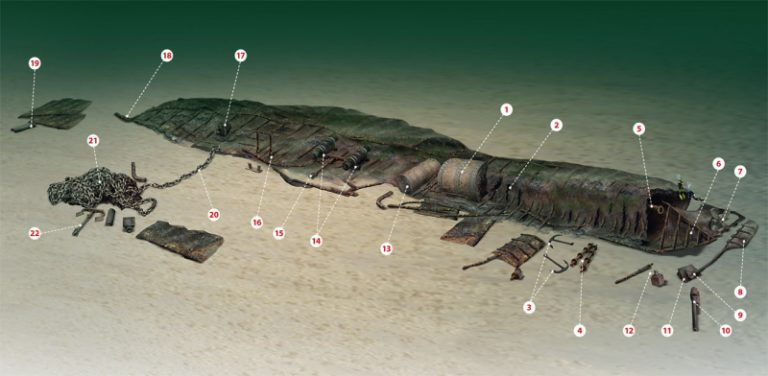This cargo vessel was in her 13th year when she hit a mine off north Cornwall. JOHN LIDDIARD makes the most of good vis, and MAX ELLIS provides the visuals.
WE’RE OFF TO THE NORTH COAST OF CORNWALL to dive a wreck off Trevose Head.
The 1370-ton steamship Poldown struck a mine laid by UC51 while carrying coal from Penarth to Boulogne. It happened on 9 October, 1917.
I dived the Poldown with the Harlyn Dive School out of Rock on the north side of the Camel estuary.
Owner Steve “Hutch” Hutchinson dropped the shot nicely across the boiler, so as usual this is where our tour begins (1).
The Poldown capsized to port, and aft of the boiler the hull has rolled and folded to the point at which the triple-expansion engine is now completely enclosed (2).
It’s not obscured, however, because there are some big holes into which to poke a light and see the cylinders inside.
I didn’t do it, but it is possible to swim through beneath the arch of the hull and pop out closer to the stern.
Continuing aft on the port side of the wreck, sections of deck and hull-plating have spilled onto the seabed at 36m.
Approximately two-thirds of the way to the stern, you’ll find a pair of small Admiralty-pattern anchors (3). These are less than half the size of the large stockless bow anchor we will see later in our tour.
Immediately next to these anchors are a pair of spindles from a cargo-winch (4). Their proximity to the stern suggests that the Poldown had one hold aft.
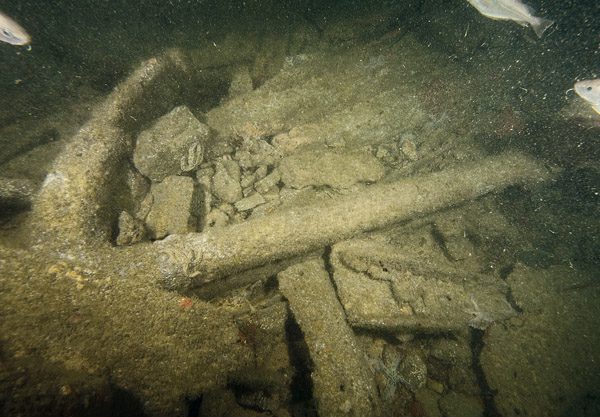
The hull is now cut through to leave a break in the propeller-shaft visible (5) where the final part of the stern has broken off (6). The strong lower part of the keel with the propeller cut-out and iron propeller (7) remains intact.
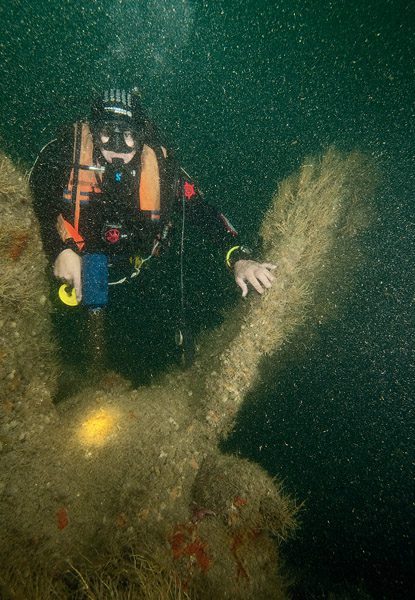
As with many wrecks in this area, the predominant encrusting life is a mixture of biscuit-brown hydroids and brightly coloured jewel anemones, with some particularly vibrant examples on the blades of the propeller.
There will typically be a few pollack about, and some curious cuckoo wrasse.
The rudder (8) has fallen from its pins and rests flat on the seabed. Towards the top of the rudder-post are the remains of the steering mechanism (9).
As was typical of most steamships in World War One, the Poldown was equipped with a stern gun to make her a Defensively Equipped Merchant Ship (DEMS). The 12-pounder gun (10) lies pointing out from the wreck just past the top of the rudder-post.
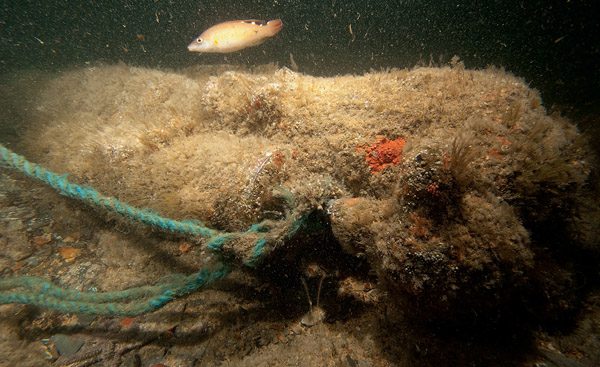
The gun-mount (11) is upside-down and pushed together with the steering mechanism. Also among the debris in this area is a mounting-block (12) from the propeller-shaft. Heading forwards again, forward of the boiler the hull has collapsed flat, but still generally spilled to port and within the overall outline of the ship.
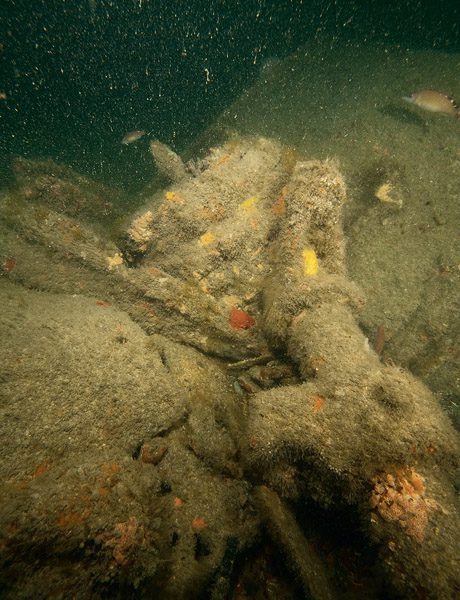
Immediately forward of the boiler is a smaller donkey boiler (13), with a boat davit lying on the seabed next to it.
The distance along the hold is short, and our tour soon comes to a pair of cargo-winches (14) that would have served the Poldown’s two forward holds. Between the winches is a large stockless anchor (15), a good twice the size of the small anchors we passed earlier.
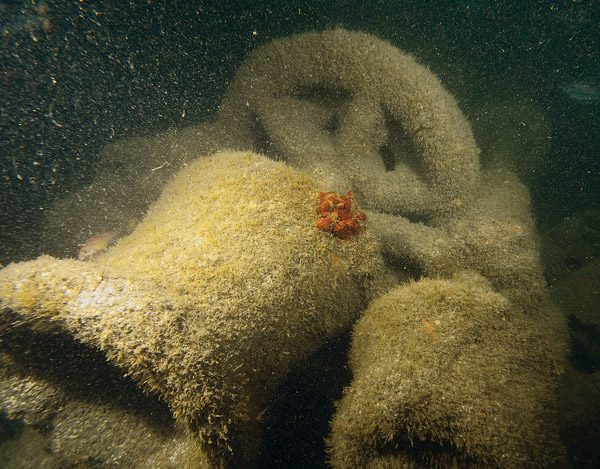
Continuing forwards, a couple of deck beams stick up vertically from the wreckage (16), though the overall hull and now the bow remains flat to the seabed.
You can tell that this is the general area of the bow by a pair of bollards next to these beams, and a cable-drum (17) with A-frame supports that would have held it above the bow deck. The hull remains flat all the way to the twisted stem-post (18).
The other side of the bow was blown off by the mine when the Poldown was sunk. It rests some 10-15m further on, with one of the anchor hawse-pipes (19).
To find the deck from the bow, you need to retrace your path back to the cable-drum (17). From here an anchor-chain (20) leads off to port in a roughly westerly direction.
Following this brings us to a large pile of chain (21) spilled from the chain-locker, together with upside-down fragments of the bow deck, the anchor-winch, the other anchor hawse-pipe, and another large stockless anchor (22).
The Poldown is quite a small wreck, so from here you could still be comfortable for time to retrace your way to the boiler and shotline, or release a delayed SMB from the bow for a drifting ascent.
IN DANGEROUS WATERS
THE POLDOWN, cargo vessel. BUILT 1904, SUNK 1917
BUILT IN 1904 BY FEVIGS JERNSKIBSBYGGERI, one of the leading Norwegian shipyards at the turn of the 20th century, the 1370-ton Poldown was originally named Pellworm and then Hawk before being purchased by the Redcroft Steam Navigation Co of Cardiff.
Boiler and triple-expansion machinery was by Richardson, Westgarth & Co of Middlesbrough.
Redcroft Steam Navigation was founded by Lewis Lougher. He went on to become chairman of many South Wales shipping companies and of the Cardiff chamber of commerce, a city councillor and then an MP.
He became Sir Lewis Lougher in 1929, and in addition to his expertise in shipping coal was responsible for the Road Transport Lighting Act of 1927, which decrees that we have white lights at the front and red lights at the rear of vehicles.
Being owned by a South Wales company, the Poldown would no doubt have carried coal on all of its outbound voyages and varied cargoes on return – perhaps from Spain iron ore, for which there was a regular back-and-forth trade, perhaps more general cargoes from other destinations.
On 9 October, 1917, the Poldown was heading from Penarth to Boulogne carrying coal when her bow ran onto a mine off Trevose Head. The vessel went under fast, taking 18 of the crew with her.
The mine had been laid by UC51 from the Flanders Flotilla. Just under a month earlier, it was another mine from UC51 that sank the St Jacques off Pembrokeshire (Wreck Tour 60) and a week after the Poldown the Admiralty drifter Active III and then the steamship Ionian also struck a mine from UC51 off Pembrokeshire.
UC51 was in turn sunk by a British mine off Prawle Point on 17 November, 1917. All hands were lost.
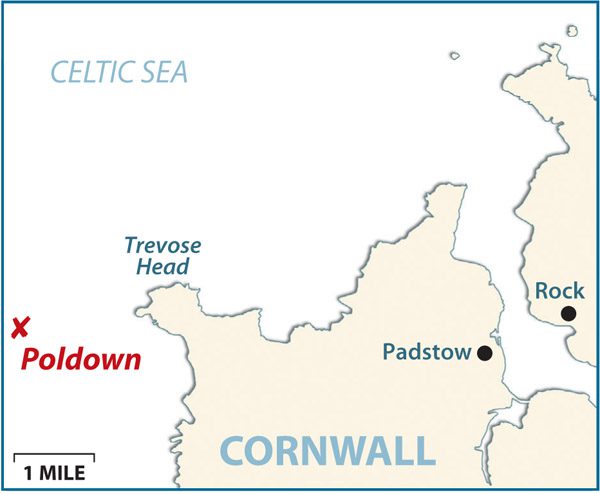
TOUR GUIDE
GETTING THERE: Follow the M5 to Exeter, A30 to Launceston, A395 to Camelford and A39 to Wadebridge, then B3314 to Rock. Harlyn Dive School is just under two miles up the hill in Pityme, by the Rock Marine boatyard.
HOW TO FIND IT: The GPS co-ordinates are 50 31.963N, 005 06.496W (degrees, minutes and decimals). The bow points to the north-west.
TIDES: Slack water is one hour after high or low water Newquay.
DIVING & AIR: Harlyn Dive School, 01208 862556
ACCOMMODATION: Plenty of options from camping to self-catering cottages, B&B and hotels. During the main season many are however reluctant to accept bookings for less than a week.
LAUNCHING: Slipway at Rock.
QUALIFICATIONS: BSAC Dive Leader or PADI Deep speciality, ideally with a decompression qualification from one of the technical agencies.
FURTHER INFORMATION: Admiralty Charts 1149, Pendeen to Trevose Head; 1168, Approaches to Padstow; and 1156, Trevose Head to Hartland Point. Ordnance Survey Map 200, Newquay, Bodmin & Surrounding Area. Dive The Isles of Scilly & North Cornwall, by Richard Larn and David McBride.
PROS: Easy to navigate in typically good visibility.
CONS: Just past the magic 35m limit for BSAC Sports Divers.
DEPTH: 35 m – 45 m
Thanks to Hutch Hutchinson and Andrew Ricks.
Appeared in DIVER July 2012
